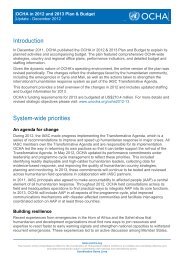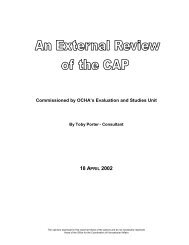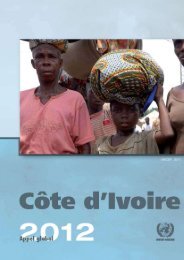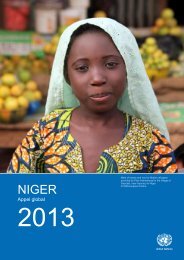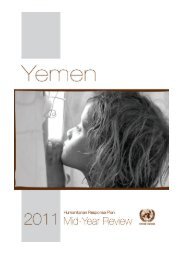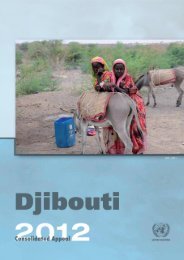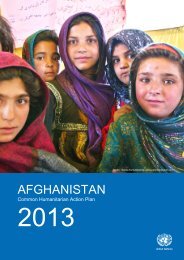SUDAN
Sudan: UN and Partners Work Plan 2012 - ReliefWeb
Sudan: UN and Partners Work Plan 2012 - ReliefWeb
- No tags were found...
Create successful ePaper yourself
Turn your PDF publications into a flip-book with our unique Google optimized e-Paper software.
66[3] Sector Response plans United Nations and Partners<strong>SUDAN</strong> WORK PLAN 2012well as ensure quarterly monitoring of progress against WorkPlan targets. The sector will conduct, distribution and postdistributionmonitoring on a regular basis. Newly displacedcaseloads are tracked by the sector lead and published to thepartners on a bi-monthly basis. The provision of environmentallyfriendly shelter is also tracked by partner reports on distributionfigures on a bi-annual basis.Bi-monthly sector coordination meetings are held at the statelevel in the three Darfur states and in Khartoum for the ROSin order to facilitate coordination, timely information sharingand capacity- building amongst all partners and stakeholders.The sector will provide quarterly updates for the 2012 quarterlyupdates on Work Plan implementation.Key sector information (Nutrition)Lead agency(s)United Nations Children's Fund (UNICEF)Gov't lead Nutrition Department (Ministry of Health)Implementing ARC, Almanar, CIS, Concern, CRS, (DATA), GOAL, GRC/agencies SRCS, Help Age, ICRC, IMC, NCA, Mayo Clinic, Medair,MERLIN, MOH, SRCS , Plan Sudan, Johaniter International,Relief and development Society, COSV, ReliefInternational, SABA, (Sawaid Health Organization), TearFund, SC-S, World Relief, UNHCR, UNICEF, WFP, WHO,WVI.Projects 26 projectsBeneficiaries 1,924,446 children under five in conflict affected States.Funds requested $51.19 millionFunds requestedper priority levelContact info$38.12 million (high)$13.07 million (medium)Susan Lillicrap, slillicrap@unicef.orgNutritionhDisaggregatedSector objectives1. Contribute to improved access to acceptable quality ofprevention, care and treatment of acute malnutrition forpopulations with critical nutrition situations or conflictaffectedareas.2. Contribute to the strengthening of MoH and partnerscapacity to identify, prepare for and respond to and mitigatenutrition problems in emergencies3. Expansion of women’s and children’s access to evidencebased high impact and feasible nutrition related servicesfor populations in crisis by empowering communities andfinding durable solutions.Sector needs analysisMalnutrition will continue to be a major driver of humanitarianneed in 2012. The acute malnutrition levels in Sudan, at 16.4percent, are above the internationally accepted emergencythreshold of 15 percent, with 5.3 percent of these childrensuffering from severe acute malnourishment. Approximately515,000 children are likely to be severely acutely malnourishedover one year in Sudan and 1.5 million children will suffer frommoderate acute malnutrition over a year (according to weightfor height z-score). Acute malnutrition figures show that moreboys than girls are malnourished.number of affected people andbeneficiaries (in thousands)Category People in need 13 Target beneficiariesMale Female Total Male Female TotalMAM 24 in all of Sudan 746 746 1,492 125 125 250SAM 25 in all of Sudan 258 258 515 75 75 150PLW 26 in conflict affected 0 488 488 0 488 488States 27Children under five in 987 937 1,924 987 937 1,924conflict affected StatesTotal 1,991 2,429 4,420 1,187 1,625 2,812The chronic malnutrition rates are high, with one in three childrenstunted (a total of1.9 million children). The worst chronicmalnutrition figures are found in Red Sea, Sennar and WhiteNile states. The 26 localized nutritional surveys carried outin Darfur in 2011 show that the levels of malnutrition thereranges from 8.7 percent (GAM, post-harvest, South Darfur)to 35.5 percent (GAM, hunger gap, North Darfur 28 ) with wideseasonal variations. Areas of concern in Darfur remain NorthDarfur and areas of South Darfur, although only limited surveysare available for West Darfur. A limited number of localizedsurveys have also been undertaken in non-Darfur states, withthe five localized surveys completed so far in 2011 showingGAM results ranging from 8.2 percent to 16.5 percent. 29A number of factors have the potential to impact the nutritionalsituation in Sudan for 2012. The fact that conflict in thethree Protocol Areas occurred during the planting season andhas affected the movement of animals may impact on foodNutrition Services and Indicators DarfurNutrition centresTherapeutic ● and supplementary ● feeding centres290 290 311 317 318261206 208 217 227 238 247216 212 227 227Admissions to therapeutic feeding centresTFC admissions per month (in thousands)Change in admissioncriteria in early 2010864Global malnutrition rates, children under 5Localized nutrition surveys (GAM, in %)20.7 22.3 21.4 24.017.6 19.1 18.68.7 9.5 12.2 13.9Nov-08Jan-09Mar-09Jun-09Aug-09Jan-10Mar-10Jun-10Aug-10Sep-10Dec-10Mar-11Jun-11Jul-11Aug-11Sep-11Apr-09Jul-09Oct-09Jan-10Apr-10Jul-10Oct-10Jan-11Apr-11Jul-1120Alsalam c. (01/11)Ottash c. (01/11)Kass (02/10)Adila (06/10)Zamzam Old(06/10)Kabkabiya (06/10)U Kedada (12/10)Krenik (10/10)S. Tobay (06/10)El Gen. (08/10)Yasin (10/10)Source: UNICEF (2011)




